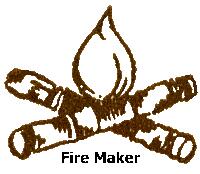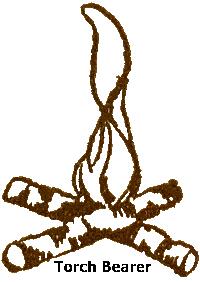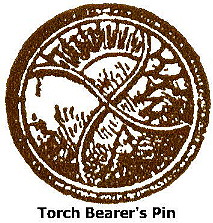| 1. Applicant
for Membership. The applicant must know
the object and requirements of the organization,
and at the monthly meeting of the Council Fire
shall announce her desire to become a Camp Fire
Girl by repeating:
"It is my desire to become
a Camp Fire Girl,
and to obey the Law of the Camp Fire, which is to
Seek beauty
Give service
Pursue knowledge
Be trustworthy
Hold on to health
Glorify work
Be happy.
This Law of the Camp Fire I
will strive to follow."
The Guardian explains the Law, phrase by
phrase. The applicant is then received on
probation as a member of the Camp Fire, until she
has fulfilled the six requirements necessary to
attain the rank of Wood Gatherer.

2. To Become a
Wood Gatherer. To complete her membership and
receive the silver ring she must fulfill the
following six requirements:
- Be a member of a Camp
Fire for at least two months.
- Attend at least six
weekly meetings and two ceremonial
meetings.
- Select a name and
symbol.
- Make a headband.
- Have the ceremonial
dress.
- Win in addition at
least ten elective honors.
Upon meeting these
requirements, a girl becomes a Wood Gatherer and
receives the Wood Gatherer's ring as a token of
her membership in the Camp Fire Girls. When she
receives her ring at a Council Fire, she must
repeat the Wood Gatherer's desire.
The ring is given without
cost and belongs to the girl even when her
membership ceases. It represents the seven points
of the Law in seven fagots bound together, and
Work, Health and Love in three raised circles on
either side of the fagots. Lost rings may be
replaced upon application by the Guardian for
fifty cents each.

As soon as a girl has
completed the requirements for a Wood Gatherer,
record of her membership is filed in the National
Office. Except under unusual conditions if a girl
does not complete her membership and so become a
Wood Gatherer in four months, she should be
dropped from the Camp Fire.
3. The
ceremonial gown and head-band are
required before a girl may become a Wood
Gatherer, because experience has shown that in
them is found the democracy of spirit, the
artistic unity, and the beauty of form, which are
so desirable in the activities of the Camp Fire
Girls. To this end only the official ceremonial
dress should be worn. The materials have been
carefully selected because of beauty of color,
durability and inexpensiveness. The decorations
on the ceremonial dress should be a symbolic or
pictographic record of the attainments,
relationships, ideals and hopes of the owner.
Thus it should grow as she does. It will become a
beautiful symbolic record of what is most
precious in the life of the girl, and may be
passed on as a priceless inheritance to her
children.
The importance of the
ceremonial gown has grown during the two years
since the Camp Fire Girls was started. At first
the girls put on decoration simply to make it
look pretty, but now no decoration has a place
that has not a meaning. The gown is simplicity
itself, and yet it offers wonderful opportunities
for telling stories. All the things a girl loves
can be symbolized and wrought into beautiful
decoration.
One Guardian has all the
symbols of her girls embroidered on the bottom of
her costume, and above each girl's symbol she has
embroidered stitches of different colors to
represent each honor won by that individual girl.
The real significance of
the ceremonial gown was not appreciated until a
Grand Council Fire was held. Then girls from
every station in life came together all clad
alike. It was just as becoming to the poor girl
as to the rich girl. Its value as bringing about
a true democratic feeling between girls of all
classes cannot be estimated. They are all one in
this great sisterhood.
Care should be taken that
the ceremonial gown should not grow common and of
little significance by being worn on the street,
in parades, etc. Camp Fire symbols, insignia and
banners can be made a distinguishing mark of the
Camp Fire Girls and save exploiting the
ceremonial gown, for it should be kept for the
more private Camp Fire activities.
In the matter of partisan
parades, such as woman's suffrage, the Camp Fire
organization cannot take sides either for or
against, although individual members among the
girls and Guardians are entirely free to identify
themselves as they please. In such cases the
ceremonial gown should not appear.
The case of pageant floats
is a little different, and many Camp Fires have
decorated floats with beautiful woodland scenes
in which they appeared in their ceremonial
dresses without sacrificing any of the delicate
personal feeling which should cling to them.

4. To Become a
Fire Maker.
(1) The candidate
must be at least thirteen years old. The Guardian
must use her best judgment in determining how
long a girl should be a Wood Gatherer before
allowing her to become a Fire Maker. It is not
merely a matter of winning the required and
elective honors. Earnestness and maturity must
also count. Any girl who is faithful ought to be
able to win the rank in a year. If a girl is
approaching the twenties, is deeply in earnest
and has time for the work, she might be allowed
to present her claim in as short a period as
three months. But this should be regarded as the
rare exception. If she is living in a Camp Fire
Girls' camp, giving her entire time to the work,
is mature, loyal and really understands the
spirit, the Guardian may allow her to become a
candidate in six weeks.
(2) The candidate
shall further indicate her love and under
standing of the Camp Fire ideal by learning and
expressing--

(3) In addition
the candidate must fulfill the Required Honors.
These honors are symbolized by purple beads.
(4) The candidate
shall present also twenty Elective Honors. At
least one honor must be won in each group, and
with the exception of Home Craft not more than
five honors may be presented from any one group.

5. To Become a
Torch Bearer.
(1) The candidate must be at
least fifteen years of age, and must be approved
by the Guardian as ready to bear the torch of
life and light to guide others. It should take a
good Fire Maker from at least six months to two
years to be ready for this rank and
responsibility. It is not merely nor mainly a
matter of winning the honors. To be a Torch
Bearer should really mean that the girl has shown
powers of steady leadership. This is the most
important qualification of the Torch Bearer.
(2) The candidate shall learn and
repeat--
A Torch
Bearer is an assistant to the Guardian. She is a
leader. That is what carrying the torch means.
(3) The candidate must be known to
the Guardian as trust-worthy, happy, unselfish, a
good leader, a good "team worker," and
as liked by the other girls.
(4) The candidate shall have led a
group of not less than three girls once a week
for not less than three months, or four times a
week for one month. It might be a group of Blue
Birds. She will naturally select things to do in
which she is proficient and which the girls like.
This does not mean that she can organize them as
Camp Fire girls. The real test is the enthusiasm
and success of the girls she teaches.
(5) The candidate shall present
fifteen honors from the list of Elective Honors
in addition to those she presented for the rank
of Fire Maker.

6. Specialist
Honors. Any Torch Bearer over sixteen
years of age may win Specialist Honors. These are
qualifications in special lines.
7. Membership
Transferable. If a Camp Fire Girl moves from
one city to another she may, when elected,
transfer her membership to a Camp Fire in the
city to which she goes. Or she may help in
organizing a Camp Fire and securing a Guardian.
She retains the rank she held in the group of
which she was formerly a member. A transfer blank
will be found in the Record Book.
8. Choosing
Camp Fire Names. The name of the Camp
Fire may be suggested by a primitive legend or
custom, by the natural resources or industries of
the locality, by some woman who has been of
special service to the community, or by the
desire of the girls as a group. A Camp Fire in
one of the Western States may be called the Alsea
Camp Fire because it is in the Alsea Valley. The
Indian legend is told that no matter how fierce
the war between neighboring tribes, in this
beautiful valley the Indians were always at peace
and so they called the valley Alsea, meaning
peace. The symbol for this Camp Fire is two low
brown triangles with bases touching, to suggest
the valley between the mountains. The Hannah
Dustin Camp Fire, situated near Deerfield,
Massachusetts, may have for its emblem a canoe
with the totem of the tribe from which she saved
herself and her little boy. The Sequoia Camp Fire
may have a reddish brown, long trunked, pointed
topped tree for its symbol because it tells of
the giant redwoods. A group of girls in Butte,
Montana, may name themselves the Copper City Camp
Fire Girls, because of the principal industry of
their home city, and they may use the pick and
shovel in copper color as their symbol. The more
simple the symbolic design the more effective it
will be and the more varied may be its use.
A Camp Fire girl chooses or
wins her own name and symbol, which stands for
the qualities or accomplishments by which she
wishes to be known. From a collection of Indian
legends the names "Wanaka," sun-halo,
and "Chelan," clear water, were taken.
One girl had been watching the oven-bird build
its nest and then took the Indian name of that
bird. Another girl took her name from the words,
"needed and cheerful," two things which
she wished to be, and now she is known as
"Neachee." "Pakwa" chose the
frog as her symbol, for its skill in diving;
"Kanxi" chose the honey-bee for its
sweetness. "Morning Star" likes to take
walks before breakfast and hopes soon to get
breakfast all alone for the other members of the
family. "Evening Star," her sister, is
the one who puts the two younger children to bed,
and she is winning her first honors in telling
folk-stories and Indian legends to them.
"Grey Leaves" found her name in the
poem, "The Master and the Trees," by
Sidney Lanier.
The names and symbols of
the Camp Fires or of the Camp Fire Girls may be
suggested from any source, especially from
folk-lore of the different countries, but are
perhaps more often taken from the Indian lore,
because it is suggestive of the spirit of
out-of-doors, of the ingenious use of the
materials at hand, and is so distinctly American.
Often, when names have been
too hastily chosen, the girls are anxious to
change them for new names. Many times a more
thoughtful study of the name will reveal some
study of symbolism not before known or realized.
If so, it is wise to hold to the original name.
But if the girl's desires have so changed that a
different name is more appropriate, let the old
name be written on a piece of paper, and at the
Council Fire the Guardian may explain the reason
for the change. She then throws the paper into
the flames and tells the girls that, as she
throws the paper into the flames, it is a sign
that the name is gone forever and must never be
mentioned by the girls again; hereafter, the girl
is to be known by her new name.
The Law in
"Air-Pictures"

|